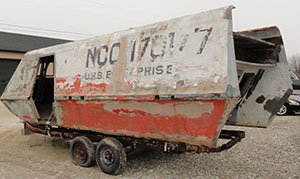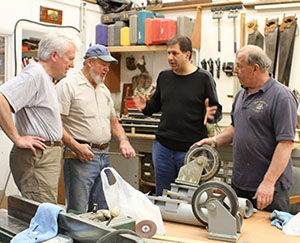For Alum-Restored Star Trek Spacecraft, Space is Not the Final Frontier
-
-
slice.mit.edu
Filed Under
Recommended

Nearly every episode of the original Star Trek television series began with the line, “Space: the final frontier.” But for one shuttlecraft used in the series, space was just the beginning.
Many trekkies recognize the Galileo as the original Trek shuttlecraft (a fictional vehicle designed for short trips in Space) that appeared in seven episodes of the original series from 1967-1969. In reality, the craft was a wobbly 23-foot-long wooden and metal prop that is today the largest surviving set piece from the show.
After the show’s cancellation in 1969, the Galileo was donated to a school for the blind and then bounced between collectors for more than 30 years before Trek aficionado Adam Schneider ’78 purchased it at an auction in 2012. The 47-year-old craft, which had not been physically maintained, was a rotted shell of its former space-traveling self.

“This was a prop that was designed to last five years—not 50,” Schneider says. “It had all kinds of structural problems. Each time it was moved it got more damaged.”
Undeterred, Schneider and his wife, Leslie, began working on its restoration with the specific goal of donating it to a museum. The team hired Hans Mikaitis of Master Shipwrights, a New Jersey-based ship builder and restorer, to refurbish and renovate the shuttlecraft.
No blueprints of how the Galileo was originally constructed are known to exist. The team had to rely on photos, episode screenshots, and input from the masses of Star Trek devotees online to recreate the shuttlecraft. The Schneiders covered the entire cost of the restoration.
Video via space.com
“We had to use the ship itself as a reference,” Schneider says, “We basically had to disassemble it to see how it was assembled.”After nine months of restoration (which included delays caused by Hurricane Sandy) and an estimated 2,000 hours of work by Mikaitis’ team, the Galileo was identically restored to its original form—plus a few upgrades, including working doors and a replica circuit board designed and donated by a fan.

“It was much more repair work than any of us expected,” says. “Master Shipwrights did a phenomenal job. They were able to restore it to the highest standards. We told them they should change their name to master spaceship builders.”
On July 31, 2013, the Galileo was officially donated to Space Center Houston, the visitor’s center for NASA’s Johnson Space Center. More than 400 Star Trek fans and celebrities attending ceremony, including Don Marshall, who played Lt. Boma in the original 1967 episode in which the Galileo first appeared. The shuttlecraft is now permanently docked at the center’s Zero-G Diner.
“We were hoping for an air and space organization to display it when it was complete,” Schneider says. “To be able to donate it to NASA—we’re absolutely thrilled.”
An avid Star Trek memorabilia collector (he owns more than a dozen miniatures ship models used during filming), Schneider admits it was somewhat bittersweet to see the Galileo depart.
“Our intention from day one was to donate it to a museum,” he says. “But it doesn’t get any bigger than the first craft ever built. Except for maybe the Enterprise in the Smithsonian—that’s about it!”
Learn more about the Galileo restoration and view a photo gallery of the year-long process at the project's official site.







